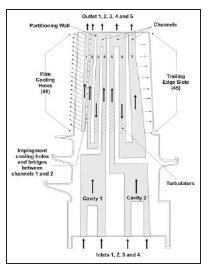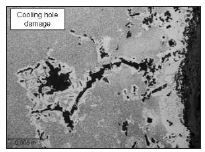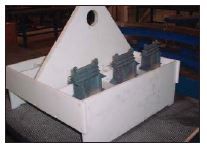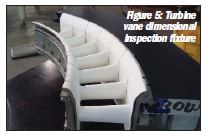Inspection of Gas Turbine Components
CRITICAL ASSESSMENT AND QUALITY CONTROL CAN ENSURE CONTINUED SAFE OPERATION OF TURBOMACHINERY
High-efficiency gas turbines (GTs) for power generation employ critical components of state-of-the-art design and advanced metallurgy. Replacement and refurbishment of these capital parts represents a significant portion of the maintenance costs incurred over the life cycle of these machines, even in older B/D/E-class designs.
Maximizing component life, and thus minimizing procurement of expensive capital spares, can substantially enhance plant profitability. A sound parts management strategy must include a detailed condition assessment and inspection plan for each component once removed from service, which invariably takes place in the power plant’s repair shop of choice.
But how well are these plans defined in practice? Are the right inspections employed and in the right sequence? Are these assessments properly documented in order to accurately track each component’s condition through a number of refurbishment cycles?
It is only recently that most plant owners have specified a shop “Inspect and Advise (I&A)” step prior to release of repair processing. However, the I&A scope of work used by shops can vary dramatically and is designed primarily to define repair costs, rather than as a tool to manage parts life.
It is incumbent upon GT plant owners and operators, therefore, to devise and specify I&A work scopes to their repair vendors that generate the necessary information to allow management of component life. Once devised, monitoring the work in the shop is crucial in order to ensure proper execution of the plan on a part-by-part basis.
Engineering of these I&A processes requires a thorough understanding of the component design, critical features of that design, prevalent service damage mechanisms and the modern inspection techniques available to characterize damage and residual life. Execution of the plan and the reports generated must then answer the question — Can this part be repaired, perform to design intent and run safely for the next planned service interval?
Parts management considerations
Establishment of inspection plans for condition assessment as part of an overall parts management strategy should take into account a variety of factors. For example, adopting the OEMs fleet-wide component life recommendations often results in retirement of parts with significant residual life. These recommendations are typically quantified by number of service intervals, such as a particular component being a “2 hot gas path interval (HGPI)” part. Service damage can vary based on site-specific operating history; and using the I&A inspection results to independently evaluate component life can result in safe life extension for many parts beyond OEM recommendations.
OEMs do not always design new parts for optimum reparability. For example, some use designs with component assemblies joined by brazing, where the disassembly necessary to conduct proper inspection and repair processes necessitates the destruction of one or more parts. In these instances, repair costs are higher due to the requirement for having new parts available for refurbishment. In fact, careful disassembly of these often complex component assemblies not only represents a major portion of the I&A work, but ensures maximum re-use of expensive detail parts (Figure 1).
Figure 1: A disassembled “F” class turbine vane with required detail parts at right

In some situations, component design deficiencies or operational conditions can exist which severely limit component life. Rather than extend life in these instances, a well-engineered and executed condition assessment protocol can serve to quantify the risk of operation within the expected “normal life” intervals.
It should be noted, however, that as part complexity rises, so does the level of effort and technical expertise required for proper I&A process execution. Thin-walled intricately cooled turbine section airfoils, for example, require diligence to ensure accurate characterization without damage to the components (Figure 2).
Figure 2 Turbine blade schematic showing a 7-channel serpentine internal cooling arrangement

Additionally, the GT component repair industry, both 3rd party companies and to a great extent the OEMs, have yet to establish consistent component inspection criteria that defines “serviceable, reparable and repaired limits.” The criteria adopted in any given situation are often driven by factors such as the end users risk tolerance, the availability of replacement parts or budget constraints. It is thus up to the user to develop and establish limits for reparability consistent with their operational philosophies, duty cycle and maintenance plan, and also inspection criteria for parts after repair processing.
Some users decide to use in situ metallurgical examinations to assess alloy degradation. Although suitable for some components, removing a small sample from a turbine airfoil in a reparable area does not offer meaningful information on the bulk metallurgical condition of the part. Users can opt to destructively evaluate a representative component to characterize metallurgical degradation.
However, these destructive evaluation inspection plans must be devised to include areas prone to metallurgical damage, including internal cooling passage surfaces. Care must be taken to ensure the component evaluated is truly representative of the balance of the set (Figure 3).
Figure 3: Metallurgical cross-section detailing turbine airfoil internal surface damage

To accurately assess the condition of a component, external coatings must be removed. Coating removal, or stripping, can be conducted by various techniques, which must remove the coating layers without touching sound parent metal or causing other damage such as intergranular attack. This step is thus critical, i.e., a qualification of the repair vendor’s stripping process should be conducted prior to releasing parts for production processing (Figure 4).
Figure 4: Typical chemical immersion setup for coating removal

First steps
One of the first steps in a typical turbine section component repair process is a high-temperature- solution heat treatment, designed to reverse metallurgical service-induced changes and to prepare the component for repair steps such as welding. Experience has shown that this thermal cycle will often open up defects to the surface not detected or documented during an earlier I&A phase. That is why many repair vendors now incorporate this heat-treat step in the I&A sequence to maximize detection of any defects present.
The sequence of steps in the I&A process can be important and should be designed to optimize “inspectability” for a given step. For example, nondestructive wall thickness measurements of parent metal should be conducted after coating removal, and surface inspections for the presence of defects are best performed after a thermal cycle or heat treatment.
The fidelity of nondestructive testing (NDT) methods has improved dramatically in the last several years. The chosen I&A process vendor must be properly equipped and employ trained technicians to take advantage of techniques such advanced ultrasonic (UT), eddy current (ET) and radiography (X-ray), and surface inspection methods such as magnetic particle or dye penetrant (visible or fluorescent).
The importance of oversight to ensure that repair vendors diligently and accurately execute the established inspection process plan cannot be overstated. Although somewhat more logistically challenging, there are no industry rules that state that the vendor performing I&A condition assessment needs to be the same as the one contracted for refurbishment. In some circumstances, it may be advantageous to use separate vendors for condition assessment and repair.
GT refurbishment
GT components most commonly removed for refurbishment are combustion section (fuel nozzles, liners, baskets, flow sleeves, transition pieces) and turbine section (rotating blades, stationary vanes, stationary blade path shroud “blocks” or ring segments) parts. In general, a condition assessment inspection of any of these components will include a series of elements.
An initial visual assessment can help to identify parts that are clearly non-reparable due to service damage before any unnecessary costs are incurred. In addition, this can detect damage during shipment. Dimensional inspections in both the assembled and disassembled condition can quantify distortion or wear in service. Interpretation of results can indicate problems inherent to design or previous repair, potential issues with assembly during the last outage, or possibly the influence of operational events in the prior service interval.
Some GT components cannot be properly inspected dimensionally without the presence of dedicated fixtures that simulate the engine fixation. These tools must be available in the I&A vendor’s arsenal (Figure 5).
Figure 5: Turbine vane dimensional inspection fixture

Component life is maximized when service intervals are selected and inspection and repair processes are conducted such that the inevitable rate of loss of healthy wall thickness is minimized.
To state another way, the single most important factor affecting GT component remaining life after service is the amount of metallurgically sound cross-sectional thickness in structurally significant areas.
In other words, nondestructive wall thickness measurements of thin-walled components, such as some combustion components or turbine section airfoils, are vital in performing independent component life management. Techniques commonly used are ultrasonic (UT) and eddy current (ET) test inspections.
With well-designed inspect and advise condition assessment inspection plans in place, competent vendors to execute the work and proper oversight, all of the required information to independently manage GT capital parts life can be obtained.